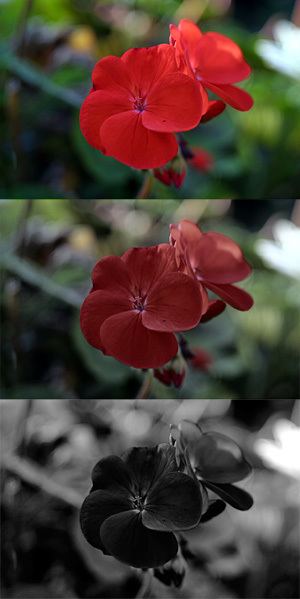 | ||
The Purkinje effect (sometimes called the Purkinje shift or dark adaptation) is the tendency for the peak luminance sensitivity of the human eye to shift toward the blue end of the color spectrum at low illumination levels. The effect is named after the Czech anatomist Jan Evangelista Purkyně.
Contents
This effect introduces a difference in color contrast under different levels of illumination. For instance, in bright sunlight, geranium flowers appear bright red against the dull green of their leaves, or adjacent blue flowers, but in the same scene viewed at dusk, the contrast is reversed, with the red petals appearing a dark red or black, and the leaves and blue petals appearing relatively bright.
The sensitivity to light in scotopic vision varies with wavelength, though the perception is essentially black-and-white. The Purkinje shift is the relation between the absorption maximum of rhodopsin, reaching a maximum at about 500 nm, and that of the opsins in the long-wavelength and medium-wavelength cones that dominate in photopic vision, about 555 nm.
In visual astronomy, the Purkinje shift can affect visual estimates of variable stars when using comparison stars of different colors, especially if one of the stars is red.
Physiology
The effect occurs because the color-sensitive cones in the retina are most sensitive to green light, whereas the rods, which are more light-sensitive (and thus more important in low light) but which do not distinguish colors, respond best to green-blue light. This is why humans become virtually color-blind under low levels of illumination, for instance moonlight.
The Purkinje effect occurs at the transition between primary use of the photopic (cone-based) and scotopic (rod-based) systems, that is, in the mesopic state: as intensity dims, the rods take over, and before color disappears completely, it shifts towards the rods' top sensitivity.
Rod sensitivity improves considerably after 5-10 minutes in the dark, but rods take about 30 minutes of darkness to regenerate photoreceptors and reach full sensitivity.
Use of red lights
The insensitivity of rods to long-wavelength light has led to the use of red lights under certain special circumstances – for example, in the control rooms of submarines, in research laboratories, aircraft, or during naked-eye astronomy.
Under conditions where it is desirable to have both the photopic and scotopic systems active, red lights provide a solution. Submarines are dimly lit to preserve the night vision of the crew members working there, but the control room must be lit to allow crew members to read instrument panels. By using red lights, or wearing red goggles, the cones can receive enough light to provide photopic vision (namely the high-acuity vision required for reading). The rods are not saturated by the bright red light because they are not sensitive to long-wavelength light, so the crew members remain dark adapted. Similarly, airplane cockpits use red lights so pilots can read their instruments and maps while maintaining night vision to see outside the aircraft.
Red lights are also often used in research settings. Many research animals (such as rats and mice) have limited photopic vision, as they have far fewer cone photoreceptors. By using red lights, the animal subjects are kept "in the dark" (the active period for nocturnal animals), but the human researchers, who have one kind of cone (the "L cone") that is sensitive to long wavelengths, are able to read instruments or perform procedures that would be impractical even with fully dark adapted (but low acuity) scotopic vision. For the same reason, zoo displays of nocturnal animals often are illuminated with red light.
History
The effect was discovered in 1819 by Jan Evangelista Purkyně. Purkyně was a polymath who would often meditate at dawn during long walks in the blossomed Bohemian fields. Purkyně noticed that his favorite flowers appeared bright red on a sunny afternoon, while at dawn they looked very dark. He reasoned that the eye has not one but two systems adapted to see colors, one for bright overall light intensity, and the other for dusk and dawn.
Purkyně wrote in his Neue Beiträge:
Objectively, the degree of illumination has a great influence on the intensity of color quality. In order to prove this most vividly, take some colors before daybreak, when it begins slowly to get lighter. Initially one sees only black and grey. Particularly the brightest colors, red and green, appear darkest. Yellow cannot be distinguished from a rosy red. Blue became noticeable to me first. Nuances of red, which otherwise burn brightest in daylight, namely carmine, cinnabar and orange, show themselves as darkest for quite a while, in contrast to their average brightness. Green appears more bluish to me, and its yellow tint develops with increasing daylight only.
